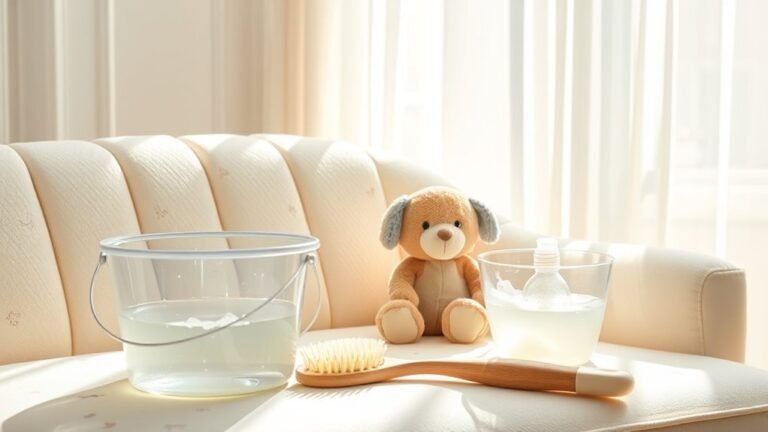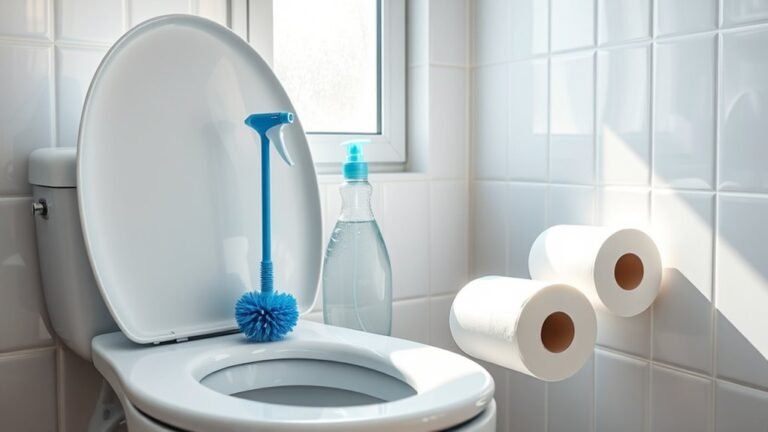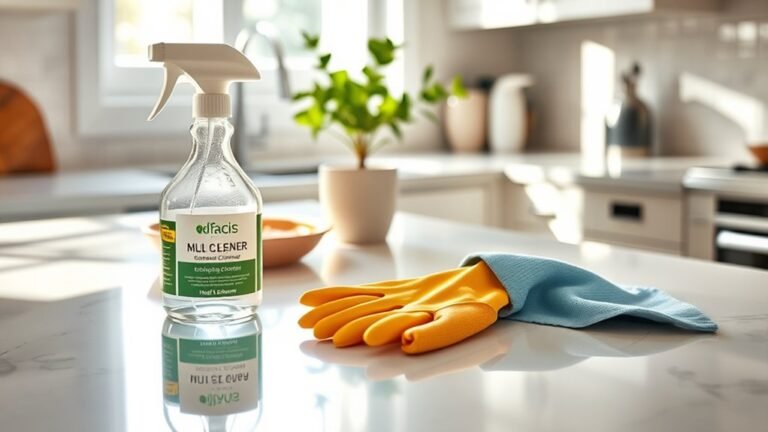Cleaning Tips for Homes in Cold, Snowy Regions
To keep your home clean in cold, snowy regions, wipe your shoes after coming in and use sturdy mats at entrances to trap salt and mud. Let mud dry before brushing it off and clean floors regularly to prevent stains. Improve ventilation and use dehumidifiers to control moisture and avoid mold. Protect floors with mats and maintain heating systems for efficiency. Want to discover easy ways to tackle winter’s mess and keep your space fresh?
Managing Salt and Snow Residue Indoors

Although it might seem minor, managing salt and snow residue indoors is essential to keeping your home clean and damage-free during winter. You want to enjoy your space without the hassle of stubborn salt stains ruining your floors or carpets. After snow removal, it’s vital to wipe down shoes and boots to prevent tracking in salt and moisture. Consider placing sturdy mats at entrances to catch residue before it spreads. Regularly clean these mats and floors to avoid buildup that can cause discoloration or corrosion. By staying proactive, you maintain a fresh, inviting home that feels like a true refuge. Embracing these simple habits means you’re free to relax without worrying about winter’s mess invading your living space.
Effective Strategies for Removing Mud and Dirt
When mud and dirt find their way indoors, cleaning them up quickly is key to preventing stains and damage. Start by letting the mud dry a bit; it’s easier to remove in clumps than as a smear. Use a stiff brush to loosen dried mud, then vacuum or sweep it away. For stubborn dirt, try a mix of warm water and mild detergent—this simple outdoor cleaning solution works wonders. Don’t forget to clean entryways and mats regularly to stop mud from spreading inside. You can also set up a designated cleaning station outside with a hose or bucket to tackle mud before it crosses your threshold. These mud removal techniques save you time and protect your floors, letting you enjoy your home without hassle.
Preventing Mold and Mildew in Damp Areas

To keep mold and mildew at bay in damp areas, you’ll want to improve ventilation and run dehumidifiers regularly. Catching and fixing water leaks as soon as they happen is also essential. These steps help maintain a dry environment that prevents mold growth.
Improve Ventilation Systems
Since dampness encourages mold and mildew growth, improving your ventilation system is essential in cold regions. You want to maintain good air quality by allowing fresh air to circulate freely throughout your home. Proper ventilation helps control indoor humidity, preventing moisture buildup that leads to mold. You don’t need complicated setups—just make certain that vents, exhaust fans, and windows work effectively, especially in moisture-prone areas like bathrooms and kitchens. Regularly check and clean your ventilation components to keep airflow steady. By doing this, you’ll create a healthier environment that feels open and fresh, giving you the freedom to enjoy your space without worrying about hidden dampness or mold issues. Good ventilation is your first line of defense against moisture problems in cold, snowy climates.
Use Dehumidifiers Regularly
Improving ventilation helps reduce moisture, but sometimes it’s not enough to keep dampness at bay, especially in colder climates where windows stay shut for long periods. That’s where using a dehumidifier regularly becomes essential. You can take control of your indoor humidity levels, preventing mold and mildew from taking hold in those damp corners. Just remember, dehumidifier maintenance is key—clean filters and empty water tanks often to keep it running efficiently. By staying on top of this, you’re not just protecting your home; you’re creating a healthier, freer living space. Don’t let moisture trap you indoors—use your dehumidifier as a powerful tool to keep your environment dry and comfortable all winter long.
Promptly Address Water Leaks
Although dehumidifiers help control moisture, you can’t ignore water leaks when they happen. Promptly addressing leaks is key to preventing mold and mildew that can trap you in costly repairs and unhealthy air. Stay ahead by mastering leak detection—catch drips early to avoid extensive water damage. Here’s how to keep your home dry and free:
- Regularly inspect pipes, faucets, and appliances for hidden leaks.
- Fix even small leaks immediately; they rarely stop on their own.
- Monitor ceilings and walls for discoloration or damp spots as early signs.
Protecting Floors From Winter Wear and Tear

When winter hits, your floors face constant challenges from snow, salt, and moisture tracked inside. To keep your floors looking great and free from damage, start by placing durable floor mats at every entrance. These mats catch grit and water before they reach your flooring, saving you from scratches and stains. Next, think about applying protective coatings designed for your floor type—whether it’s wood, tile, or laminate. These coatings create a barrier against moisture and wear, making clean-up easier and extending your floor’s life. Remember, regular maintenance during winter isn’t a chore; it’s your way to keep your space feeling open and free from winter’s harsh effects. With the right prep, your floors can handle the season without holding you back.
Cleaning and Maintaining Heating Systems
To keep your heating system running efficiently, you’ll want to replace furnace filters regularly. Don’t forget to inspect your chimney and vents to prevent blockages and guarantee safety. These simple steps can help you avoid costly repairs and keep your home warm all winter.
Regular Furnace Filter Replacement
Changing your furnace filter every one to three months is essential for keeping your heating system running efficiently. Sticking to a proper filter replacement schedule not only improves air quality but also reduces energy costs, giving you more freedom from high utility bills. Here are key furnace maintenance tips to keep in mind:
- Check your filter monthly during peak usage to decide if it needs replacing sooner.
- Use high-quality filters designed for your specific furnace model.
- Mark filter change dates on your calendar or set reminders to avoid forgetting.
Chimney and Vent Inspection
Although you might not think about it often, regularly inspecting your chimney and vents is essential for keeping your heating system safe and efficient. Neglecting chimney maintenance can lead to blockages or creosote buildup, which pose fire hazards and reduce airflow. By scheduling routine vent cleaning, you guarantee that your heating system breathes freely, boosting performance and cutting energy costs. Take charge of your home’s safety by checking for cracks, leaks, or obstructions in your chimney and vents. If you’re not comfortable doing it yourself, hire a professional to handle thorough inspections and cleanings. Staying proactive with chimney maintenance and vent cleaning not only protects your home but also grants you the freedom to enjoy a warm, worry-free winter.
Tackling Ice Buildup on Windows and Doors
When ice builds up on your windows and doors, it not only blocks your view but can also damage the seals and frames over time. You don’t have to feel trapped by winter’s grasp—simple ice removal techniques can free your home from this icy hold. Start by gently scraping away ice with plastic tools to avoid damage. Better yet, apply window insulation tips like sealing gaps with weatherstripping or using insulating film to reduce frost buildup. Consider these steps to regain control:
- Use a hairdryer on low heat to melt ice safely without cracking glass
- Apply a vinegar-water solution to prevent refreezing
- Regularly check and maintain weather seals for lasting protection
With these strategies, you’ll keep your windows and doors clear, functional, and ready for winter’s challenges.
Keeping Entryways Clean and Dry
Since entryways are the main passage points between the outdoors and your home, keeping them clean and dry is essential to prevent dirt, moisture, and ice from spreading inside. You can maintain freedom from mess by placing durable entry mats right at the door. These mats trap snow and dirt before it sneaks indoors, saving you from extra cleaning. Boot trays are another must-have; they catch water and slush from your boots, stopping puddles from forming on your floors. Make it a habit to wipe down your mats and trays regularly to keep them effective. By setting up this simple system, you’ll enjoy a cleaner, drier entryway that welcomes you without hassle, offering freedom from constant indoor mess and slippery spots.
Proper Ventilation to Reduce Indoor Moisture
Even in cold regions, proper ventilation is key to keeping indoor moisture under control. You want to avoid excess humidity that can cause mold and damage. Focus on improving air circulation without sacrificing your comfort or freedom inside your home.
Try these simple steps for effective humidity control:
- Use exhaust fans in kitchens and bathrooms to vent moist air outside.
- Open windows briefly during dry, sunny days to refresh indoor air.
- Keep air vents and registers clear to promote consistent airflow throughout rooms.
Winter-Friendly Cleaning Tools and Products
Although cold weather can make cleaning more challenging, choosing the right tools and products will make your tasks easier and more effective. You’ll want eco friendly cleaners that work well in low temperatures and versatile scrubbers that tackle everything from stubborn salt stains to indoor grime without damaging surfaces. These tools help you maintain a fresh, healthy home without sacrificing your values or freedom.
| Tool/Product | Benefit |
|---|---|
| Eco Friendly Cleaner | Safe, effective, and green |
| Versatile Scrubber | Multi-surface, durable |
| Microfiber Cloths | Traps dust, gentle on skin |
Using these winter-friendly essentials guarantees your cleaning routine stays efficient, freeing you up to enjoy the season without hassle.
Frequently Asked Questions
How Often Should I Deep Clean My Carpets During Winter?
Imagine stepping onto a plush carpet, free from winter’s grime and salt stains. For carpet maintenance during winter cleaning, you should deep clean your carpets every three to four months. This helps you avoid the buildup of dirt tracked in from snowy boots and keeps your home feeling fresh. Sticking to this schedule lets you enjoy a cozy, clean space without feeling bogged down by constant upkeep, giving you more freedom to relax.
Can Houseplants Help Improve Indoor Air Quality in Winter?
Absolutely, houseplants can boost your winter air quality by naturally filtering toxins and adding humidity, which tends to drop indoors during colder months. These houseplant benefits not only freshen your space but also create a more comfortable, breathable environment when you’re stuck inside. Plus, caring for plants gives you a sense of freedom and connection with nature, brightening those long winter days while improving the air you breathe.
What Are the Best Non-Toxic De-Icers for Sidewalks?
You want sidewalks clear, safe, and kind to the earth—no harsh chemicals, no damage, no worries. For the best non-toxic de-icers, turn to natural alternatives like sand, kitty litter, or beet juice mixtures. These eco-friendly options melt ice gently, protect plants, and keep pets safe. You’ll enjoy freedom from harmful salts while walking confidently outside, knowing you’ve chosen solutions that care for your home and the planet alike.
How to Safely Store Outdoor Furniture During Snowy Months?
To safely store your outdoor furniture during snowy months, start by giving everything a good clean and dry. You’ll want to invest in durable furniture covers that protect against moisture and snow damage. If you have space, explore storage solutions like a shed or garage to keep your pieces out of the elements entirely. That way, your furniture stays in great shape, and you’re free to enjoy it when warmer weather returns.
Are Humidifiers Beneficial for Winter Home Comfort?
You’ll find humidifiers really beneficial for boosting your winter home comfort. Different humidifier types—like ultrasonic, evaporative, or steam—help maintain ideal moisture levels, preventing dry air that can irritate your skin and respiratory system. By controlling humidity, you’ll feel cozier without cranking up the heat. Just pick a type that fits your lifestyle, and you’ll enjoy a freer, more comfortable living space all season long.






